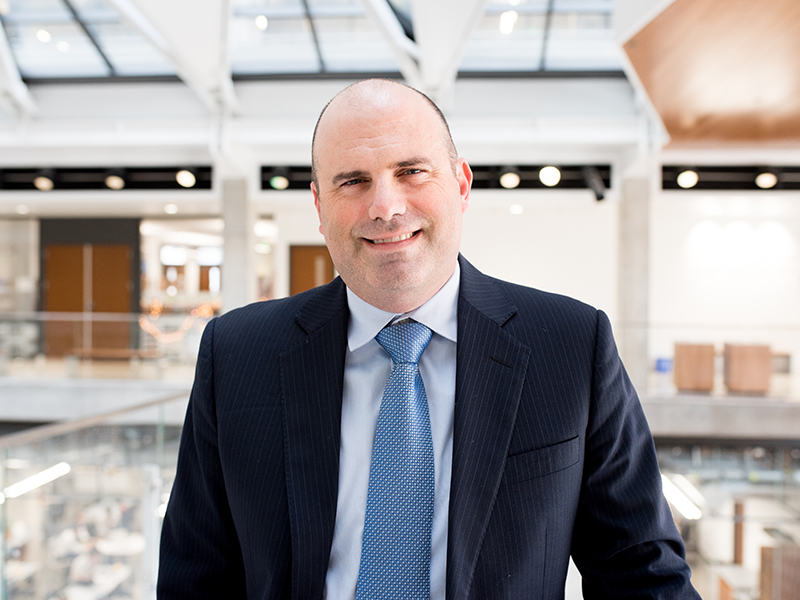Transportation continues to be a hot topic in research and political circles across the U.S., but in Austin, it’s sweltering. Led by the Cockrell School of Engineering, UT Austin is a globally respected hub for transportation research, education and innovation.
Smarter Transportation Infrastructure for the Nation, State
Recently, the University’s Center for Transportation Research (CTR) was selected by the U.S. Department of Transportation to be one of only 13 Beyond Traffic Innovation Centers (BTIC) in the U.S. and to help lead the new Automated Vehicle Proving Ground Partnership program in Texas. With these two new designations, CTR further strengthens its role as a strategic USDOT partner in the development of a safer, smarter transportation infrastructure.

Chandra Bhat, professor in the Cockrell School of Engineering’s Department of Civil, Architectural and Environmental Engineering
“We are excited about the combination of the BTIC and the proving ground designations, which will enable knowledge sharing and collaborative projects with top transportation-related researchers,” said Chandra Bhat, professor in the Department of Civil, Architectural and Environmental Engineering and director of CTR. “This gives our researchers an even greater opportunity — and responsibility — to make our nation’s transportation system more efficient, reliable, safe, and equitable.”
USDOT developed the BTIC program to utilize resources and top talent in select regions and to recognize forward-thinking and influential institutions capable of finding solutions to the challenges identified in Beyond Traffic, a 2015 report highlighting current and anticipated conditions of our nation’s transportation systems.
“The overarching vision of our BTIC is to build ladders of opportunity by working with our researchers and students to address fundamental transportation questions, especially as they relate to Texas,” Bhat said. “We want to build on our record of megaregional planning in ways that will be transferrable to other U.S. megaregions to transform transportation systems.”
Michael Walton, Cockrell School of Engineering professor and the designated program coordinator, will form a BTIC working group consisting of long-time collaborators, including the Texas Department of Transportation, the City of Austin, the North Central Texas Council of Governments and the Southwest Research Institute (SwRI).
In addition to the BTIC designation, USDOT also named Texas a national autonomous vehicle proving ground for the testing of connected and automated vehicle technologies. This designation establishes Texas as a leader in the research and development of new transportation technologies that could make roads safer and less congested. The partnership includes CTR, TxDOT, Texas A&M Transportation Institute, SwRI and 32 municipal and regional partners with a shared interest in the mobility and safety challenges facing the introduction of autonomous and connected vehicles to public roadways.
The Texas partnership is one of 10 designees in a community of practice that will be instrumental in helping USDOT provide insights into big data usage and further develop guidelines for automated vehicle technologies.
Building a Real-Time Car-to-Car Communication Network
Many of today’s cars come equipped with radar, cameras and other sensors that continuously collect important information — a data trove that could be shared between cars and infrastructure to improve safety and traffic efficiency.
For this to happen — and for it to be utilized in real time — engineers need to develop a wireless communications system that can support the exchange of large amounts of data in under a few milliseconds. Conventional technologies, such as dedicated short-range communication and 4G cellular communication, just aren’t up to the task.

Robert Heath, professor in the Cockrell School of Engineering’s Department of Electrical and Computer Engineering
With this in mind, transportation researchers, led by professor Robert Heath in the Cockrell School’s Department of Electrical and Computer Engineering, are finding ways to leverage millimeter-wave bands, an under-utilized frequency spectrum that is now being tested for 5G communication, to support the gigabit-per-second data rates that are required for this new car-to-car communication. They discuss their approach and propose the design of equipment to be used in vehicles and road infrastructure in a recent issue of IEEE Communications Magazine.
In the coming months, using state-of-the-art prototyping equipment, they hope to demonstrate the use of millimeter-wave communications for high-bandwidth applications, including downloading 3D maps for precise navigation and exchanging real-time sensing data that provides information about roadway conditions and traffic.
Student-Driven Innovation
With high-occupancy toll lanes increasingly being considered a means to relieve congestion and generate revenue, graduate student Venktesh Pandey decided to explore pricing strategies to make the most of them.
And he recently received the Milton Pikarsky Memorial Award from the Council of University Transportation Centers for his work. The nationally recognized award is given annually for the best Ph.D. dissertation and M.S. thesis in the field of science and technology in transportation studies.
“His thesis is aimed at better pricing strategies for dynamic toll lanes, like the ones recently opened on Austin’s MoPac Expressway,” said Stephen Boyles, Cockrell School professor and Pandey’s advisor. “Finding the right pricing strategy is difficult, and past research has had to make some severe assumptions like the facility only having one entrance and exit point or having perfect knowledge of driver behavior.”
Pandey’s research takes important steps to making these models more realistic, which can help dynamic toll lanes be as effective as possible.
